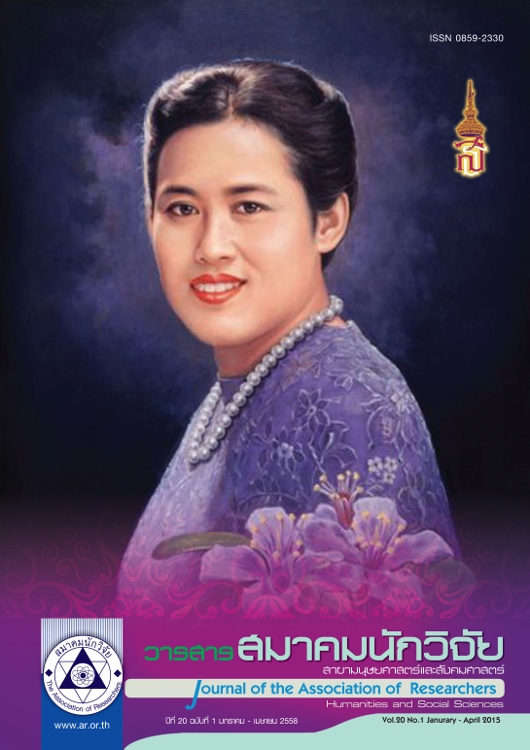The Impact of Agricultural Demographic Structural Change on Food Security in Thai Agricultural Sector
Main Article Content
Abstract
The objectives of this study are to study characteristics and trends of demographic structural change in main cereal production sectors such as rice, maize and cassava and also to study the impacts of demographic structural change on food security. Some finding of this study reveals a trend of change of agricultural labor, in 2020 labor for rice; maize and cassava production would highly fall. The
considerable decrease affects production quantity and when analyzing with Social Accounting Matrix (SAM) it is found that the rice sector will decrease in production quantity. When comparing to predicted
production quantity, an increasing trend is discovered. It could be explained that if agricultural labor still decrease, the production quantity in each sector will also fall despite it should increase for
supporting situations such as ASEAN Economic Community(AEC) and Free Trade Agreement. The objectives of this study are to study characteristics and trends of demographic structural change in main cereal production sectors such as rice, maize and cassava and also to study the impacts of demographic structural change on food security. Some finding of this study reveals a trend of change of agricultural labor, in 2020 labor for rice; maize and cassava production would highly fall. The
considerable decrease affects production quantity and when analyzing with Social Accounting Matrix (SAM) it is found that the rice sector will decrease in production quantity. When comparing to predicted
production quantity, an increasing trend is discovered. It could be explained that if agricultural labor still decrease, the production quantity in each sector will also fall despite it should increase for
supporting situations such as ASEAN Economic Community(AEC) and Free Trade Agreement.
Article Details
บทความที่ปรากฏในวารสารนี้ เป็นความรับผิดชอบของผู้เขียน ซึ่งสมาคมนักวิจัยไม่จำเป็นต้องเห็นด้วยเสมอไป การนำเสนอผลงานวิจัยและบทความในวารสารนี้ไปเผยแพร่สามารถกระทำได้ โดยระบุแหล่งอ้างอิงจาก "วารสารสมาคมนักวิจัย"
References
secretariat, February 2010. Braun Von, Joachin, T, Broca A.(1992). Improving Food Security of the Poor: Concept, Policy and
Programs. International Food Policy Research Institute, Washington D.C. Bloom,D. Canning,and G. Fink(2011), Implications of population aging for economic growth,
Working Paper 16705 http://www.nber.org/papers/w16705 Campbell C. (1991). Food insecurity: A nutritional outcome or a predictor variable? Journal of Nutrition, 121, pp. 408-415. Dixon PB, Parmenter BR, Powell AA and Wilcoxen PJ (1992) Notes and Problems in Applied General Equilibrium Economics, Amsterdam: North-Holland. pp. 95-101. FAO. (1983). World Food Security: a Reappraisal of the Concepts and Approaches. Director General’s Report. Rome. FAO. (1999). Assessment of the Impacts of the Uruguay Round on Agricultural Markets and Food Security. CCP 99/12 Rev. Rome, FAO. October 1999. FAO. (2002). The State of Food Insecurity in the World 2001. Rome. Freshwater, D (2000), the new structure of agriculture, Western Agrifood Institute, Western Agrifood Institute Electronic Colloquium. Haddad, L., J. Sullivan and E. Kennedy. (1991). Identification and Evaluation of Alternative Indicators
of Food and Nutrition Security: Some Conceptual Issues and an Analysis of Extant Data.
Washington, D.C.: International Food Policy Research Institute. Judith Banister, David E.and Larry R(2010). Population Aging and Economic Growth in China, PGDA Working Paper No. 5, http://www.hsph.harvard.edu/pgda/working.htm Kendall, A., Olson, C.M., & Frongillo, E.A., Jr.(1995). Validation of the Radimer/Cornell measure of hunger and food insecurity. Journal of Nutrition, 125, pp. 2793-2801. Leisinger.M(2002). Six Billion and Counting Population Growth and Food Security in the 21st Century, International Food Policy Research Institute. Marcoux, A. (1994). Ageing rural populations in the developing countries: patterns, causes and
implications. In:Ageing and the Family: Proceedings of the United Nations International
Conference on Ageing Populations Marcoux, (2001). Population ageing in developing societies: how urgent are the issues? Rome: FAO. Available from www.fao.org/sd/2001/pe0403a_en.htm in the Context of the Family, Kitakyushu, Japan, 15-19 October 1990, pp. 144-148. Sales No. E.94.XIII.4. Paarlberg, R.(1999). The week link between world food markets and world food security. Policy reform, market stability and food security. Proceedings of a Conference of the International Agricultural Trade Research Consortium, University of Minnesota. Staatz, J. M., V.C. D’Agostino and S. Sundberg.(1990). Measuring food security in Africa: conceptual, empirical, and policy issues. American Journal of Agricultural Economics December: pp. 13111317.
Stloukal, L.(2001). Rural population ageing in poorer countries: possible implications for rural
development. Rome: FAO. Available from www.fao.org/sd/2001/pe0501a_en.htm. Stloukal, (2004). Rural population ageing in developing countries: issues for consideration by FAO. Rome: FAO. Available from http://www.fao.org/sd/dim_pe3/pe3_040401a1_en.htm. United Nations Development Programme.(2009). Development Challenges for the Arab Region: Food Security and Agriculture. Regional Bureau for Arab States, New York. World Bank. (1986). Poverty and Hunger: Issues and Options for Food Security in Developing Countries. Washington DC. World Bank. (2008). Agricultural Prices: Global Economic Prospects 2008: Inflation and Commodity Markets. January 9. [http://web.worldbank.org/] Xiujian PENG(2008). Population Ageing, Labour Market Reform and Economic Growth in China – A Dynamic General Equilibrium Analysis, Centre of Policy Studies Monash University.


